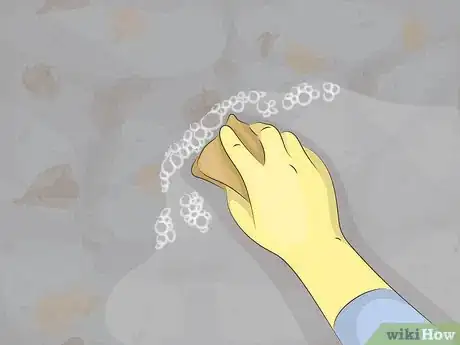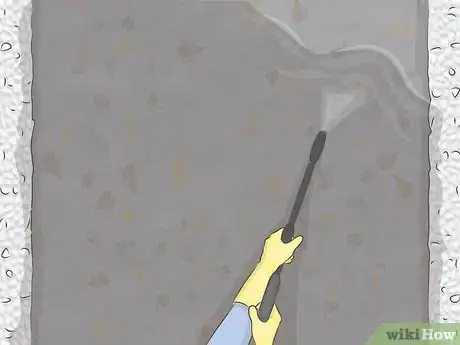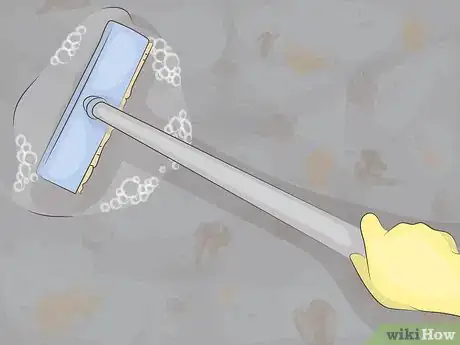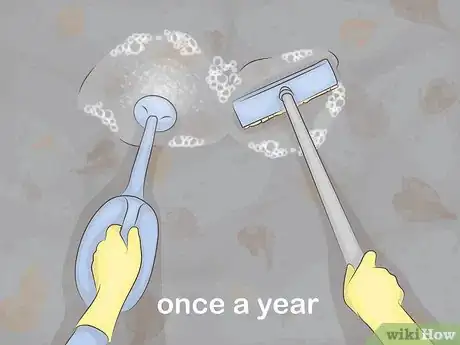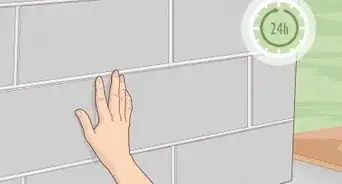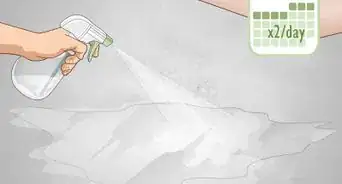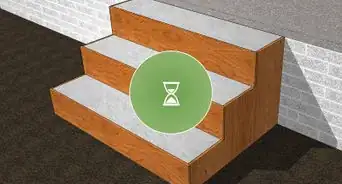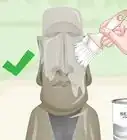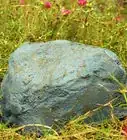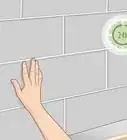This article was co-authored by Grant Wallace. Grant Wallace is a Landscaper and Owner of Grantlanta Lawn in Atlanta, Georgia. With over seven years of experience, he specializes in lawn maintenance and landscape installation. In 2012, he earned his BA from the University of West Georgia. Grant has been profiled in Shoutout Atlanta, Canvas Rebel, and Voyage ATL.
There are 9 references cited in this article, which can be found at the bottom of the page.
This article has been viewed 34,989 times.
If your home has a concrete area or driveway with trees and plants nearby, it’s expected that leaves will fall on the surface. Concrete is porous so as the leaves decay, their colour pigments can leach into and stain the concrete.[1] Removing these stains is easy with a little effort and the right tools.
Steps
Preparing the Area
-
1Sweep the concrete area with a broom. Remove any leaves and debris from the surface. Leaves that have settled on the surface for longer are more likely to stain the concrete.[2]
- Although the leaf stains may be concentrated in a small area, it's best to clean the entire slab. Otherwise it can look patchy if you only clean the stained areas.[3]
-
2Put on protective clothing. Depending on what agent you use to clean the stains, you may need to wear gloves or safety glasses.[4] Wear closed footwear to prevent exposed skin coming into contact with the chemicals.Advertisement
-
3Make the cleaning agent in a bucket. Most products will require you to dilute them with a few gallons or litres of water. You can use a regular laundry detergent with bleaching properties (e.g. Oxiclean) or a special organic stain remover. Granular detergents are also great as they provide added friction when scrubbing.[5]
- Darker, tougher stains may not be removed with detergent.
- You can also prepare the cleaning agent in a watering can. This can help with applying it during the cleaning process.
-
4Spot test the cleaning solution first with a sponge. Choose a stained area that is hidden from view. If you have coloured concrete, some chemicals may cause the colour to change or fade.[6]
-
5
Cleaning the Stains
-
1Wet the stained concrete with plain water. Use a garden hose or a pressure washer. This will help remove any remaining debris from the surface. Damp concrete will allow the cleaning agent to permeate better.[9]
-
2
-
3
-
4Rinse the concrete surface. Once it is clean, wash all the detergent or organic stain remover from the concrete. Dispose of the contaminated water safely. Leave the concrete to dry.
- You may have to repeat the process if the stains have not been removed completely. Organic stains are carbon-based, making them the toughest to remove.[18]
Maintaining the Concrete
-
1Clean the concrete every so often. Aim to do it once a year. This will help to extend the lifespan of the concrete and keep its colour bright. It will also stop stains and grime from building up.[19]
-
2Fill cracks in the concrete. Use mortar or a concrete filler. Repairing cracks reduces water seeping into the concrete and degrading it.[20]
-
3Use a sealant to seal the surface. A thin coat of sealant is usually applied with a roller or sprayer. It can prevent the concrete from staining and provide resistance against UV sunlight and abrasions from foot traffic. [21]
Expert Interview
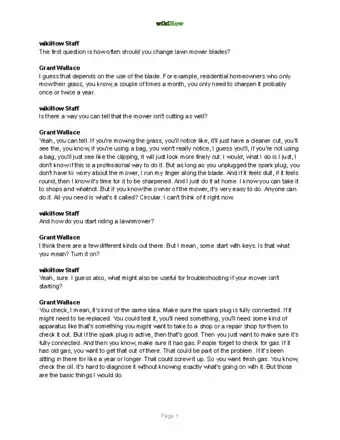
Thanks for reading our article! If you'd like to learn more about removing stains, check out our in-depth interview with Grant Wallace.
References
- ↑ https://www.totallandscapecare.com/business-best-practices/how-to-keep-pavers-clean/
- ↑ https://www.totallandscapecare.com/business-best-practices/how-to-keep-pavers-clean/
- ↑ https://www.concretenetwork.com/fix-concrete-cleaning/removing-stains-leafs-pinecones.html
- ↑ https://www.installitdirect.com/learn/concrete-stain-removal/
- ↑ https://www.concretenetwork.com/fix-concrete-cleaning/removing-stains-leafs-pinecones.html
- ↑ https://www.installitdirect.com/learn/concrete-stain-removal/
- ↑ https://www.nrdc.org/stories/6-ways-you-can-help-keep-our-water-clean
- ↑ https://www.concretenetwork.com/fix-concrete-cleaning/removing-stains-leafs-pinecones.html
- ↑ https://www.concretenetwork.com/fix-concrete-cleaning/removing-stains-leafs-pinecones.html
- ↑ https://www.familyhandyman.com/tools/how-to-use-a-pressure-washer/view-all/
- ↑ https://www.familyhandyman.com/tools/how-to-use-a-pressure-washer/view-all/
- ↑ https://www.bobvila.com/articles/driveway-cleaning/
- ↑ https://www.concretenetwork.com/fix-concrete-cleaning/removing-stains-leafs-pinecones.html
- ↑ https://www.familyhandyman.com/tools/how-to-use-a-pressure-washer/view-all/
- ↑ https://www.familyhandyman.com/tools/how-to-use-a-pressure-washer/view-all/
- ↑ https://www.installitdirect.com/learn/concrete-stain-removal/
- ↑ https://www.installitdirect.com/learn/concrete-stain-removal/
- ↑ https://www.concretenetwork.com/fix-concrete-cleaning/removing-organic-stains.html
- ↑ https://www.concretenetwork.com/concrete/maintaining/
- ↑ https://www.concretenetwork.com/concrete/maintaining/
- ↑ https://www.concretenetwork.com/concrete/maintaining/
- ↑ https://www.concretenetwork.com/concrete/maintaining/sealingplain.htm
- ↑ https://www.totallandscapecare.com/business-best-practices/how-to-keep-pavers-clean/



